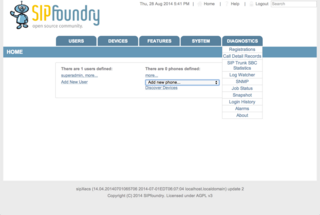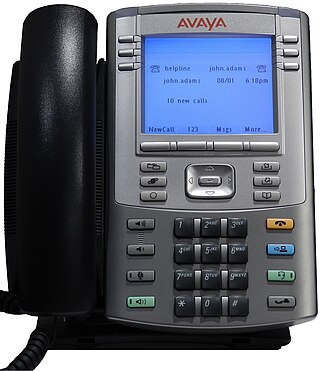Related Research Articles
Voice over Internet Protocol (VoIP), also called IP telephony, is a method and group of technologies for voice calls, the delivery of voice communication sessions over Internet Protocol (IP) networks, such as the Internet.

Asterisk is a software implementation of a private branch exchange (PBX). In conjunction with suitable telephony hardware interfaces and network applications, Asterisk is used to establish and control telephone calls between telecommunication endpoints, such as customary telephone sets, destinations on the public switched telephone network (PSTN), and devices or services on voice over Internet Protocol (VoIP) networks. Its name comes from the asterisk (*) symbol for a signal used in dual-tone multi-frequency (DTMF) dialing.

Digium, Inc. is a communications technology company based in Huntsville, Alabama, and since 2018, a subsidiary of Sangoma Technologies Corporation. The company makes VoIP business phone systems, IP phones, and hardware products. It was founded in 1999 by Mark Spencer.
Media Resource Control Protocol (MRCP) is a communication protocol used by speech servers to provide various services to their clients. MRCP relies on another protocol, such as Real Time Streaming Protocol (RTSP) or Session Initiation Protocol (SIP) for establishing a control session and audio streams between the client and the server.

SipXecs is a free software enterprise communications system.
Mobile VoIP or simply mVoIP is an extension of mobility to a voice over IP network. Two types of communication are generally supported: cordless telephones using DECT or PCS protocols for short range or campus communications where all base stations are linked into the same LAN, and wider area communications using 3G or 4G protocols.
Unified communications (UC) is a business and marketing concept describing the integration of enterprise communication services such as instant messaging (chat), presence information, voice, mobility features, audio, web & video conferencing, fixed-mobile convergence (FMC), desktop sharing, data sharing, call control and speech recognition with non-real-time communication services such as unified messaging. UC is not necessarily a single product, but a set of products that provides a consistent unified user interface and user experience across multiple devices and media types.

Avaya IP Phone 1140E in telecommunications is a desktop Internet Protocol client from 1100-series manufactured by Avaya for unified communications. The phone can operate on the Session Initiation Protocol (SIP) or UNIStim protocols. The SIP firmware supports presence selection and notification along with secure instant messaging. This device has an integrated 10/100/1000BASE-T auto-sensing Ethernet switch with two ports and an integrated USB port, and is Bluetooth capable. The SIP version of this phone has full IPv6 functionality and only requires 2.9 watts of power.
An IP PBX is a system that connects telephone extensions to the public switched telephone network (PSTN) and provides internal communication for a business. An IP PBX is a PBX system with IP connectivity and may provide additional audio, video, or instant messaging communication utilizing the TCP/IP protocol stack.

Elastix is a unified communications server software that brings together IP PBX, email, IM, faxing and collaboration functionality. It has a Web interface and includes capabilities such as a call center software with predictive dialing.
Voxeo Corporation was a technology company that specialized in providing development platforms for unified customer experience (self-service) and unified communications applications. Voxeo was headquartered in Orlando, Florida with main offices in Cologne, Germany; Beijing, China; London, UK and San Francisco, US.
Aculab is a privately held, UK-based limited company that was founded in 1978. It is a designer, developer and manufacturer that specialises in providing API-driven, enabling technology sub-systems for telecommunications related OEM products such as are used in fixed line PSTN, wireless and VoIP networks. Aculab's products are sold worldwide, primarily through direct sales and also via the reseller channel. Aculab's headquarters and R&D facilities are located in Milton Keynes, UK. It has a branch office in Norwood, Massachusetts, USA.

GM Voices is a company and recording facility that specializes in voice prompts for IVR and automated phone applications, GPS, and telematics/remote diagnostics. Business presentation narration services are also offered. Currently, GM Voices provides recordings, translation, and language localization services in 100 languages and dialects.
Loquendo is an Italian multinational computer software technology corporation, headquartered in Torino, Italy, that provides speech recognition, speech synthesis, speaker verification and identification applications. Loquendo, which was founded in 2001 under the Telecom Italia Lab, also had offices in United Kingdom, Spain, Germany, France, and the United States.
VaxTele SIP Server SDK is a complete development toolkit, which allows software vendors and Internet telephony service providers (ITSP) to develop SIP Server and (SIP) Session Initiation Protocol based VoIP systems for Microsoft Windows to install computer to computer voice chat, chat rooms, IVR systems, call center services, calling card services, dial/receive computer to PSTN and mobile phone calling services.
Voice Elements is a Microsoft a Cloud Service and Calling Plan for Microsoft Teams. Voice Elements was released by Inventive Labs Corporation in 2008, based on their original CTI32 toolkit. Software developers who use C#, VB.NET or Delphi use Voice Elements to write telephony-based applications, such as Interactive Voice Response systems, voice dialers, auto attendants, call centers and more.
The 1100-series IP phones are 6 different desktop IP clients manufactured by Avaya for Unified communications which can operate on the SIP or UNIStim protocols. The SIP Firmware supports presence selection and notification along with secure instant messaging.

The FreePBX Distro is a freeware unified communications software system that consists of a graphical user interface (GUI) for configuring, controlling, and managing Asterisk PBX software. The FreePBX Distro includes packages that offer VoIP, PBX, Fax, IVR, voice-mail and email functions.
References
- ↑ Klie, Leonard (August 22, 2008). "The 2008 Market Leaders". Speech Technology Magazine. Retrieved March 3, 2010.
- ↑ "Interview with Ed Miller, CEO, LumenVox". Speech Technology Magazine. October 1, 2002. Retrieved March 5, 2010.
- ↑ Lessner, Ivy (October 2, 2007). "Nuance Buys New York Software Firm". TheStreet.com. Archived from the original on June 6, 2011. Retrieved March 5, 2010.
- ↑ "Speech Engine". LumenVox. Retrieved March 5, 2010.
- ↑ "Application Notes for LumenVox Speech Engine and LumenVox MRCPv1 Server with Avaya Interactive Response" (PDF). Avaya. August 20, 2009. Retrieved March 5, 2010.
- ↑ "IVR solutions using Aculab's media processing boards and software". Aculab. Archived from the original on March 14, 2010. Retrieved March 5, 2010.
- ↑ "LumenVox Speech Engine Achieves Compliance with BroadSoft's BroadWorks Platform". Speech Technology Magazine. May 22, 2008. Retrieved March 5, 2010.
- ↑ "Applications, CMU Sphinx". Carnegie Mellon University. Archived from the original on March 4, 2010. Retrieved March 5, 2010.
- 1 2 Tehrani, Rich (May 11, 2007). "Asterisk Fuels Speech Technologies". Communications and Technology Blog – Tehrani.com. Retrieved March 5, 2010.
- ↑ "LumenVox Speech Tuner". LumenVox. Retrieved March 5, 2010.
- ↑ "LumenVox, Top VoIP Company 2008: FierceVoIP, Fierce 15". FierceVoIP. November 4, 2008. Archived from the original on December 25, 2010. Retrieved March 5, 2010.
- ↑ "LumenVox and Digium Partner to Offer Speech-Enabled Asterisk". LumenVox. March 13, 2006. Retrieved March 5, 2010.
- ↑ Mohney, Doug (January–February 2008). "Advanced Applications of Asterisk". VON Magazine. Archived from the original on April 8, 2008. Retrieved March 5, 2010.
- 1 2 Bernier, Paula (November 2009). "Open Source Efforts No Longer an 'Obscure Sideshow of Geeks'". Internet Telephony Magazine. Retrieved March 5, 2010.
- ↑ Barnard, Patrick (December 11, 2009). "LumenVox's Speech Engine Now Available via the Software-as-a-Service Model". TMCnet.com. Retrieved March 5, 2010.
- ↑ Meisel, William (January 2010). "LumenVox and Digium offer $7.99/month speech recognition with Asterisk IVR" (PDF). Speech Strategy News. Archived from the original (PDF) on July 17, 2011. Retrieved March 9, 2010.
- ↑ Chaloyan, Arsen (December 27, 2008). "Interop with LumenVox". UniMRCP Project. Retrieved March 5, 2010.
- ↑ Chaloyan, Arsen (March 26, 2009). "LumenVox MRCPv2 Interop". UniMRCP Project. Retrieved March 5, 2010.